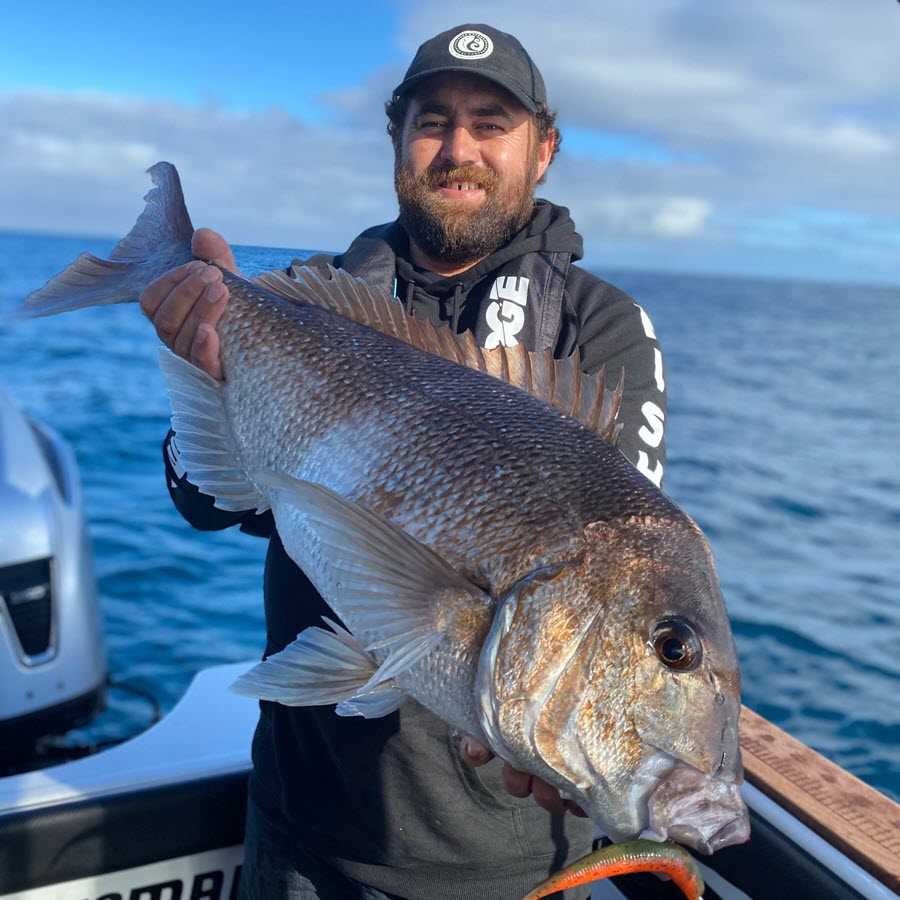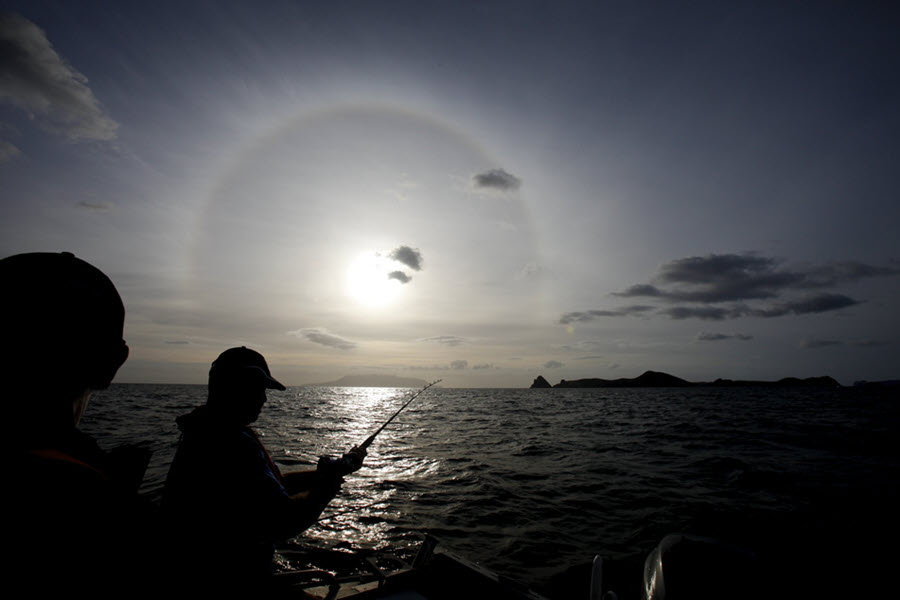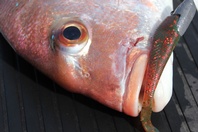Moon Tide Fishing: Fishing to the Maramataka
Moon Tide Fishing is an exciting Māori Television series that celebrates fishing to the maramataka – the Māori Lunar Calendar. Presented by Nore Martin, the fishing show highlights traditional mātauranga (knowledge) about when and where to fish in accordance with the maramataka. This mātauranga has been helping to feed tangata whenua for generations. Now in season two, this series sees host Nore Martin take viewers on another entertaining and informative journey throughout Aotearoa, proving once again that the maramataka works everywhere.
Nore provides the following insights into the maramataka and offers advice about how it can help others to better plan their fishing activities and increase their chances of success.
 Throughout Moon Tide Fishing’s the 13 episodes presenter Nore Martin explains the influences the lunar calendar has on angling success.
Throughout Moon Tide Fishing’s the 13 episodes presenter Nore Martin explains the influences the lunar calendar has on angling success.
As a keen young fisherman growing up in a place called Mitimiti on the west coast of North Hokianga, my father taught me how to fish, net in the surf, and gather shellfish from a young age. Surfcasting off the beach and rocks is how we mostly fished and, to this day, it remains one of my favourite fishing styles.
Over the years, we always fished to the moon phases and very rarely did we come home unsuccessful. The spring tides, for example, around the full and new moon allowed an opportunity to access certain rocks and outer sand banks where larger fish would be present. This would also be ideal for collecting certain types of shellfish, and when the west coast was calm enough to dive, we could also gather pāua, kina, and kōura.
During the neap tides, particularly those seven days following the rise of the full moon (known as the ‘Tangaroa Phases’) would often be a perfect time to net in the surf for kanae (grey mullet). Around this time the tides are smaller, and the surf would often be calm enough to gather kanae safely. These ‘Tangaroa Phases’ would also be the most productive time for most fishing activities, and often brought a settled weather pattern and calmer waters.
 Just as his ancestors did, Nore paces down his knowledge to young angler Flyn Jack.
Just as his ancestors did, Nore paces down his knowledge to young angler Flyn Jack.
Although I grew up fishing to the moon phases, I didn’t fully understand what the maramataka was until I was in my teenage years. It was at this time that my father showed me a copy of a document from the early 1900s, which had been handwritten by one of our tūpuna (ancestors), listing the names of each moon phase and a brief explanation of what they were good for, or not so good for. This sparked my interest in understanding and learning more about the maramataka, a field of study which has seen a huge resurgence in recent years.
To successfully fish according to the maramataka, it is important to understand what maramataka is. In its simplest explanation, maramataka can be described as a Māori lunar calendar system that follows the moon phases, tracking time through the days and nights of the traditional Māori months. However, it is also much, much more than that.
The maramataka plays a vital role in our relationship with the environment and is an important indicator in monitoring our personal wellbeing during the moon’s various phases, including the impacts of the different energies associated with each phase. Through many years of observation, from our ancestors’ time until now, we can identify when the best and worst times are to plant, fish, and plan important events, but also when to give the environment a break and take time to look after ourselves. The existence of the maramataka is thousands of years old and links back to a time long before our ancestors first arrived in Aotearoa. Evidence of this can be seen in many of the other Pacific Islands, where the use of maramataka also exists, and the names of its respective phases are remarkably similar.
In the maramataka, each moon rise is referred to as a phase, whereas we might often think of phases as being restricted to the new moon, first quarter, full moon, and last quarter. Tribal distinctions may present as subtle differences in the names of the maramataka phases, but overall, they are very similar.
 Landbased fishing features prominently throughout the series.
Landbased fishing features prominently throughout the series.
Another point of difference with the maramataka is that it does not follow the same system of measuring time as the Gregorian calendar. The Gregorian calendar follows a solar system of time measurement, spread over 365 or 366 days in a year starting from the first of January, with each day beginning at midnight and lasting 24 hours. The maramataka, on the other hand, measures time by following a monthly lunar cycle starting in Whiro, the new moon, and ending in Mutuwhenua, the day before the next new moon. The first month of the Māori year begins in Pipiri, usually around June, depending on when Whiro rises. In this lunar month, we observe the rise of certain stars, such as the Matariki cluster (Pleiades) or Puanga (Rigel) – markers of the new year. Many tribal areas will set their maramataka calendar to start from the rise of one moon phase to the rise of the next, while some coastal areas may set the start of their phase according to the high or low tides, which closely precede or follow the rise of that phase.
The relationship between the moon, stars, and the sun is also important. Traditional knowledge expert and Māori astronomer Professor Rangi Mātāmua explains that the maramataka determines the days (and nights) of the lunar months, and the stars indicate what month of the year we are in, while the sun’s position on the horizon helps to identify the seasons.
Another interesting point about the traditional Māori seasons, as explained to me by my mentor, respected kaumātua (esteemed elder) and traditional knowledge expert Rereata Makiha, is that we did not traditionally have four seasons in a year. There are, in fact, thirteen seasons, known as kaupeka. Six of these make up the cooler period of the year, and seven of these make up the warmer period of the year.

Combining this mātauranga with what we observe in the environment around us can help to determine when things will happen over the year. This can indicate what the seasons might bring, such as weather patterns, planting and harvesting, the spawning activity of fish and shellfish, the migration of land, sea, and freshwater species to different areas, and the flowering of certain plants and trees, to name just a few examples.
It is important that while we follow the traditional knowledge that has been handed down to keep us alive and healthy, we must also contribute to its expansion for generations to come, by recording our own observations in the current changing environment. Learning never stops, and I am grateful to people such as Rereata Makiha, who has been a pivotal influence during my continued growth as I have developed a deeper understanding of the maramataka.
My experiences over many years of fishing according to the maramataka have taught me a lot, and now I’m on a journey to share this knowledge as the presenter for Moon Tide Fishing, while also learning a few new things along the way.
 What it is all about – Moon Tide Fishing explains the influence the moon has on all facets of our lives, not just catching dinner.
What it is all about – Moon Tide Fishing explains the influence the moon has on all facets of our lives, not just catching dinner.
Next issue, Nore will reflect on some of the people he has fished with over the show’s two seasons, as well as some of the amazing locations, and he will share his guide to how to use the maramataka to improve your fishing success.
Recent Posts Visit Forum


POPPING VANUATU
in Popper and Topwater Fishing13 hours ago
FarmerBrowne
Halco Rooster Poppers and River to Sea Dumbell poppers are also commonly used and effective where I mostly fish now days (Aitutaki). I personally find the...

Spammers Beware!
in Forum comments and feedback15 hours ago
Pcj
How does it keep getting through??Edit Grunta: All gone Paul - I've removed the links as they don't go anywhere but thanks for the heads-upThe reality...

Auckland Yakkers
in Yak Yak Yak15 hours ago
Hard Yakker
The birds were at Campbells today, yes all of the birds, I've never seen so many birds. It was a hot session, and surely a bad...
What I Bought Today
in T.A.S (Tackle Acquisition Syndrome)19 hours ago
Mc Tool
I used to manage a service dept for a nationwide department store , and once I got my head around stock control I was gobsmacked at ...
Popular Articles

Softbait Fishing - Part 1 - gear selection
John Eichlesheim writes an article about selecting the right equipment for softbait fishing... Read More >

Softbait fishing Pt 2 - tips and tricks
Techniques, tips and tricks of softbait fishing – getting the most from your soft baits.... Read More >

Surfcasting - setting yourself up
Gary Kemsley helps sort out the necessary gear for intending surf fishers.... Read More >

Squid - How to catch them
Squid fishing is a rapidly growing aspect of fishing - Paul Senior shares some hints and tips to get started.... Read More >
Fishing Reports Visit Reports
Bream Bay Fishing Report - 18/04/24
Change in seasons, change in tactics Not a lot to report in the ‘big fish’... Read More >
Canterbury Fishing Report - 04/04/24
Fish galore! Coming off the back of Easter Weekend and with some very nice weather... Read More >
Raglan Fishing Report - 04/04/24
Excellent snapper action There is some excellent autumn snapper fishing straight out and up the... Read More >
Bream Bay Fishing Report - 04/04/24
Whangarei Harbour fishing well Like the weather, the fishing has been patchy throughout Bream Bay... Read More >

Comments